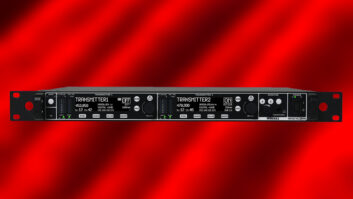Apogee (booth 6428) revealed Ensemble, a multichannel digital audio interface designed specifically for use with a Mac and can be controlled natively within Apple’s Logic Pro software.
“This is an exciting revolution in native recording,” says Betty Bennett, co-founder and CEO of Apogee. “We worked very closely with Apple to craft a professional solution that would fully integrate with Apple software. I am confident our customers will be quite pleased with the quality, ease of use and affordability of this very special product.”
According to Rob Schoeben, Apple’s VP of applications marketing, “With Logic Pro 7, Apple brought a new level of sophistication to computer-based music production, while our development community created an incredible ecosystem around it. We have worked closely with Apogee so that their new FireWire audio interface not only sets new standards for sound quality and performance, but is also a natural extension of Logic Pro 7.”
Ensemble features 36 channels of simultaneous audio, including eight channels of Apogee’s A/D and D/A conversion; four transparent, digitally controlled 75dB mic preamps; eight channels of ADAT I/O; two channels of S/PDIF co-ax and optical I/O; and FireWire connectivity to and from the computer. Ensemble also includes such Apogee features as SoftLimit, UV22HR and Intelliclock.
For additional information on Ensemble (which is available next month), visit www.apogeedigital.com/ensemble.
Apogee’s Maestro is a software application for controlling, routing and mixing functionality with Apogee hardware on the Mac. Maestro is capable of controlling Apogee hardware I/O connected to the computer via FireWire, Symphony (Apogee’s PCI Express card) or both at the same time. Maestro features full Ensemble functionality control, multiple low-latency mixers, hardware control panels and an input/output routing matrix compatible with Rosetta 800, Rosetta 200, AD-16X and DA-16X. Other features include mic preamp controls for Ensemble and output/headphone gain controls.
Maestro is a universal application, designed to run natively on both Power PC and Intel-based Mac computers, and will be available next month.
Apogee will also unveil a Symphony, a multichannel PCI Express card designed specifically for use with Apple’s Macintosh computers. Apogee’s Symphony PCI Express card is a digital computer interface that is based on the PCI-Express architecture in Apple’s PowerMac G5 computers. Controlled by Apogee’s Maestro software, Symphony features 32 channels of digital I/O on a single PCI-Express card format. With support for sample rates up to 192 kHz, Symphony can be used as a digital router or patchbay when connected to external converters or other digital outboard equipment. Software drivers for Symphony will feature extensive
routing capabilities and very low-latency performance. Symphony connects directly to Apogee’s Rosetta and AD-16X and DA-16X converters via the X-Symphony option card, which installs in the slot of the converter itself.
With the ability to install three cards in Apple’s G5, Symphony offers a connectivity solution for high-end, professional users who want to use up to 192 channels of audio simultaneously in a single computer, providing more than enough I/O for even the biggest scoring sessions.
Symphony is compatible with any CoreAudio software applications and will also be available next month.







